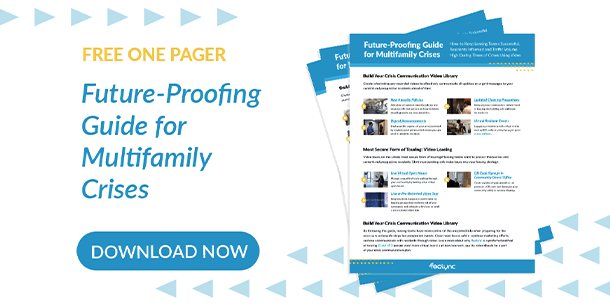All industries are increasingly embracing and investing in crisis management planning in case of emergencies. 62% of companies have crisis plans.
It’s hard for on-site teams to know what to do for residents during a crisis. It’s challenging not to get caught up in the what-ifs and what to-dos. It’s important to keep tabs on any warning signs that might help you get ahead of a crisis before it unfolds.
While I’m sure you have a crisis communication plan in place, think about the overall tone, flow, and timing for how each message will be perceived and delivered. How can you emphasize and ensure your message is communicated properly? Video!
It’s nothing you haven’t heard before that in times of crisis leasing teams should over-communicate community updates, new rules, and regulations to residents while simultaneously keeping themselves safe and informed. And, video is a great way to communicate information to employees, prospective and current residents so they can fully grasp your message. Here’s our guide to help corporate and on-site teams work together to keep residents informed, and traffic volume high during times of crisis.
How to Incorporate Video Into Your Crisis Management Plan
When preparing how to provide updates and instructions to employees and residents, below are suggestions to make your communication efforts more efficient through video.
- Communication efforts should be transparent: While preparing communication efforts through video, be honest with employees and your residents about the situation. This ensures everyone has the most up-to-date information regarding the crisis and what protocols should be followed. Leasing teams can create a video saying that amenities are closed until further notice and when/if you expect them to open back up. Or, a video saying how hours of operations are being modified and what those new hours are. Always keep it real!
- Information should be easily accessible: 85% of consumers use smartphones to access email. Emails are a great way to send updated information quickly and in real-time, and an email including a video can increase your email click-through rate by up to 300%. Residents need the human connection and seeing a familiar face on video may ease their concerns.
- Communication should be intentional: Decide what types of emails need to be created and distributed to current or prospective residents, and be sure to incorporate video. A video explaining how amenities are currently closed is a perfect example of communicating via email to current residents but not necessarily prospective residents.
Keep Your Leasing Teams Safe
While residents need to feel comfortable in their homes, your leasing staff needs to feel supported as well. Use video to keep leasing teams safe and successful; follow our suggested ways below!
- Continue or strengthen your leasing strategy. A key consideration corporate teams will need to decipher is if and when tours should resume when unforeseen crises happen. Video tours are the safest, most secure form of touring. See how Bozzuto was prepared to switch to fully virtual touring in 2020 and now continues to provide video tours alongside in-person tours!
- Allow flexible working conditions. Having a pre-recorded video library allows teams to stay safe, successful and provides the ability to work remotely. Hear how one leasing agent closed a lease in 22 minutes – sight unseen while on his way to dinner!
- Host virtual open houses. Virtual open houses are a convenient and safe way to reach prospective residents without ever having to leave your desk! See how the Remy hosted a virtual open house, which resulted in 9 leases!
After the Crisis
After the crisis, corporate and on-site teams should assess the effectiveness of communication efforts. Then, teams should determine what processes should remain in the crisis plan or what should be improved. One way to do this is by checking your video analytics – track open rates, views, and other engagement metrics. But, to do this – you need a multifamily-built video leasing and engagement solution, such as Realync!
Teams must remember to follow up on any information they promised to provide residents with or when/if rules and regulations have been lifted. In addition, teams can release updates and notify how the recovery is progressing. And how can this information be communicated? You guessed it – video!
Get In Touch!
Realync works to improve existing processes and help teams build, foster, and retain relationships with current and prospective residents during times of crisis and beyond!
Close more leases, market more effectively, engage with residents and, as always, keep it real. Do you have a question or suggestion or want to learn more about what you read? Email us at contact@realync.com. We’d love to hear from you!

